Ovetto Recycling Bin
by: EnviroGadget, 2011-08-19 09:00:36 UTC
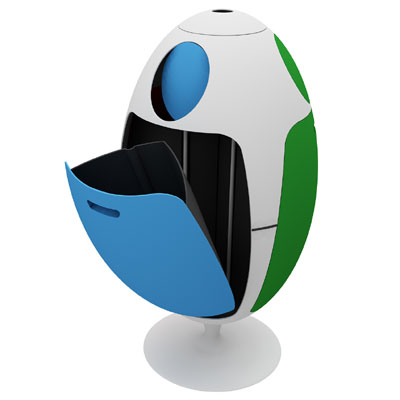
The Ovetto Recycling Bin is a beautiful and stylish way for you to dispose of your household rubbish. The segmented design helps to make recycling simpler, with 3 different sections to take different types of refuse.
The Ovetto Recycling Bin has been created by Italian architect Gianluca Soldi. The recycling bin has a sleek curved design that has a modern feel to it, allowing it to fit into any home, school or office easily. The bin spins on its axis allowing you to either place it pride of place in the middle of a room, or to tuck it away into a corner and still have access to all 3 sections quickly and easily. Each of the 3 sections of the bin has a main compartment which opens up to allow for easy bag removal and a small upper circular covered opening for you to post your waste through. There is a central bottle crusher at the top of the bin to allow you to condense the rubbish easily.
The Ovetto Recycling Bin seals tightly to prevent any nasty smells leaving the bin. Each section can be lined with bin liners or even left over shopping carrier bags. The brightly coloured sections help you to be able to separate your rubbish into 3 groups quickly and efficiently, different coloured sections are available to allow you to match the door colour with the colour of outdoor recycle bin. The recycling bins are all made from a minimum of 40% recycled plastic themselves, up to a maximum of 70% recycled plastic.
The Ovetto Recycling Bin is an aesthetically pleasing way to help section your rubbish to make recycling easier and more fun. The spinning bin allows you easy access to any section whenever needed while being an attractive addition to any kitchen or workplace.
The Ovetto Recycling Bin is just £182.60 include shipping.
Want to buy this gadget? Check out the Ovetto Recycling Bin article on EnviroGadget to see the lowest prices for this gadget.
© 2008 to 2011 EnviroGadget.com. You can now keep up with the latest eco-gadgets on the EnviroGadget Facebook page. Why not help us to spread the word?
Related posts:
- Tin Can Recycling with the Frog Can Crusher
- All-in-One Home Recycling Centre
- The Green Recycled and Recyclable 16-Ounce Mug By Aladdin


 Biomimicry's Debt to Ray Anderson
Biomimicry's Debt to Ray Anderson
by: Greener Design, 2011-08-15 04:00:41 UTC
Among the many achievements that Ray Anderson earned in his revolutionary career, one of the most often-overlooked is his pioneering use of biomimicry in product design.

 Flotspotting: "Eat Play Grow" by Ruth Vatcher
Flotspotting: "Eat Play Grow" by Ruth Vatcher
by: Core77, 2011-08-19 17:00:00 UTC

We've seen at least a few domestic garden concepts on Coroflot in the past—from Ori Mishkal's artsy take on a plantable table to Igor Lobanov's "Sprout Pen"—but Ruth Vatcher's concept is somewhat more practical.

I can't pretend to be an expert on the category, but "Eat Play Grow" table is easily one of the most interesting articles of educational childrens' furniture I've come across.
The growing table is designed to encourage children to grow their own food. The simple yet functional design is aimed at being placed in an interior setting such as a kitchen or a bedroom. The child is encouraged to grow herbs or vegetables as well as prepare the food. Simple storage solutions such as the use of felt allow the child to store tools discretely. The table is designed to be simple and subtle, integrating healthy living into a child's life from a young age. It is designed to educate children and promote healthy living.
The combination of materials was chosen so that the product remains versatile and timeless, easily becoming part of a child's daily life. Functions of the table include; a herb sprouting tray, a chopping board for food preparation, a watering pot and felt storage system. The storage system reduces storage space and keeps the material usage to a minimum. It is designed to store tools and acts as an alternative to drawers and trays.

(more...)


 Where and How We Work
Where and How We Work
by: Core77, 2011-08-20 00:00:00 UTC
 Joya Fragrance Design Studio
Joya Fragrance Design Studio
There is something nice about taking a break from your own work to see how and where other creative people work. It's great voyeuristic fun to see how designers, artists, and makers of all kinds surround themselves with inspiration, tools, and certain comforts. More photographers are jumping in to document the kind of wonderful, crazy creative spaces of the kind that the Selby and Sight Unseen cover so well, and we recently came across a few with some good studio eye candy. With straightforward names like the Makers Project (by Jennifer Causey) and Where They Create (by Paul Barbera), both publish photographic stories of the unique worlds built by creators.
 Jeweler Erin Considine
Jeweler Erin Considine
The Makers Project is smaller in scope, focused mainly on small entrepreneurs working in design, fashion, and food in Brooklyn. There's a nice post on fragrance designers Joya, documenting the process of making their own slipcast porcelain packaging for candles. Printmaker Lena Corwin, co-creator of the Lines & Shapes books, is shown making a print. Jeweler Erin Considine makes and dies some rope necklaces. The Mast Brothers make a few of their handcrafted chocolate bars. Overall, Makers Project is a nice view into the various creators inhabiting New York, and their effort in making a living doing so.
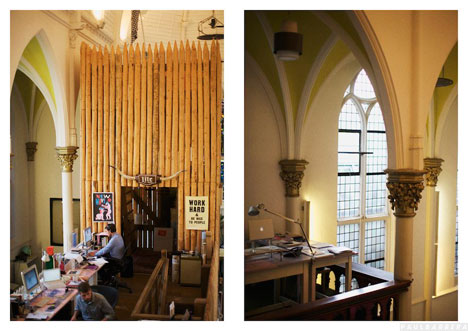 Ad Agency Kessels Kramer
Ad Agency Kessels Kramer
Based in Australia, Barbera's Where They Create casts a wider net, photographing architects, choreographers, chefs, artists, etc wherever he travels for work. It's especially fun to see the bigger, collective workspaces that are not just home studios or individual spaces. Kessels Kramer ad agency in the Netherlands did a wild build-out from logs and various found objects, housed inside of what appears to be a church, stained glass and all. Melbourne graphic designers 3 Deep also have a great re-purposed space. The site has a ton of beautiful coverage, and Frame magazine recently published a book of the same name, including 32 studios with interviews and descriptions. So many wonderful takes on workspace from Sydney to Shaghai in one spot is great inspiration to get back to your own work. Or work on your space.
More images after the jump
(more...)


 Maria Strømme On Making A Lithium-Ion Battery Using Algae
Maria Strømme On Making A Lithium-Ion Battery Using Algae
by: fast company, 2011-08-19 14:48:02 UTC
Here comes the next generation of innovators revolutionizing batteries. Maria Strømme was on the research team that developed a battery using algae.
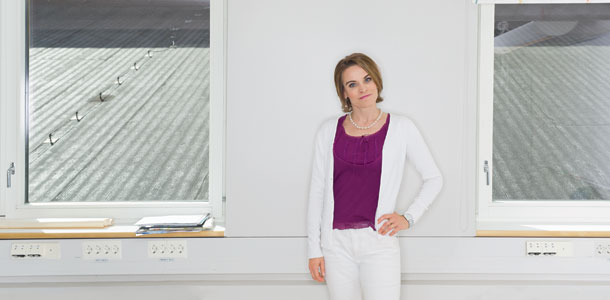 Photo by Christian Aslund
Photo by Christian Aslund
Maria Strømme
Professor of Nanotechnology
Upsalla University, Upsalla, Sweden
Strømme, 41, was on the research team that developed a battery using algae. It's now figuring out how to make it as powerful as a lithium-ion battery.
 "The materials used in today's lithium-ion batteries come from limited resources. So we need to think about new materials. We're making batteries with electrodes made from algae cellulose. The first version is supercheap and very environmentally friendly but has very low energy density. The electrodes consist of algae cellulose coated with polypyrrole, a conducting polymer. To use it for large-scale applications--in the automotive industry, for example--we'd need to increase the energy density while keeping the structure simple, keeping it made out of renewable materials, and using a production process that doesn't require a lot of energy. We're working on a second generation, which would have much greater energy density than the first, which means we can make a lithium-ion battery using algae!"
"The materials used in today's lithium-ion batteries come from limited resources. So we need to think about new materials. We're making batteries with electrodes made from algae cellulose. The first version is supercheap and very environmentally friendly but has very low energy density. The electrodes consist of algae cellulose coated with polypyrrole, a conducting polymer. To use it for large-scale applications--in the automotive industry, for example--we'd need to increase the energy density while keeping the structure simple, keeping it made out of renewable materials, and using a production process that doesn't require a lot of energy. We're working on a second generation, which would have much greater energy density than the first, which means we can make a lithium-ion battery using algae!"
A version of this article appears in the September 2011 issue of Fast Company.
More Fast Talk: Battery Power
Paula Hammond


 Unclogging Chinese Traffic With A Bus System That Works
Unclogging Chinese Traffic With A Bus System That Works
by: fast company, 2011-08-19 17:25:19 UTC
Traffic in Guangzhou (as in all of China) used to be out of control. A new bus system with dedicated lanes and smarter route planning is starting to ease congestion.

China's transportation sector is troubled, to say the least. A problematic, pricey high-speed rail system and traffic jams that last for days are just a few of the issues that have arisen as China's population continues to grow. But amidst these problems is a transportation model to be hopeful about. Guangzhou, China--the third largest city in the country--opened a 14-mile bus rapid transit corridor last year in an attempt to lower congestion on one of the city's main roads. And so far, it's really working--so well, in fact, that the corridor could be used as an example for other Chinese cities, and perhaps even cities around the world.
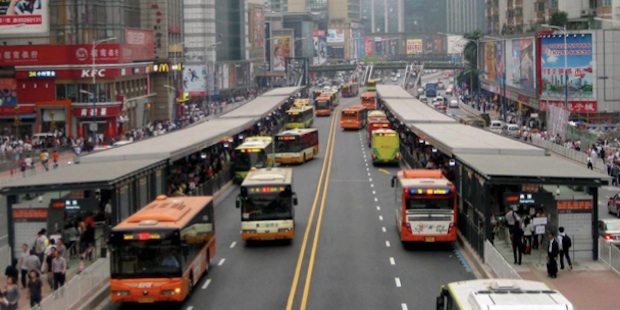
The Institute for Transportation and Development Policy (ITDP) released this week a preliminary report examining the successes of Guangzhou's bus corridor along Zhongshan Avenue, which now has 805,000 daily boardings--giving it the title of most-used bus corridor in Asia--and an increase in the bus speed of 29% compared to the previous bus system in the area (before and after pictures are above). The system is so efficient that Guangzhou's bus system has slashed operating costs by over $14 million annually. So how did Guangzhou do it?
Most of the corridor's success is the result of crafty route planning. Before the system was implemented, over 40 bus routes served Zhongshan Ave. There were no segregated lanes for buses, causing traffic to increase because of frequent bus stopping points. An on-board payment system also significantly slowed down boarding times. The report explains how the new system has changed:
All stations have overtaking lanes allowing multiple sub-stops and express routes, and are designed and dimensioned according to the projected passenger demand and bus flows. Access to the center median stations is via a combination of pedestrian bridges, at-grade crossings, and pedestrian tunnels where combined with metros. Intersections along the corridor have restricted left turns. The system uses a "direct service" or "flexible" operational plan which allows buses to enter and leave the segregated lanes, instead of requiring transfers to/from feeder routes.
[vimeo 21714344]
The new corridor has another feature that bus systems in the U.S. could take a hint from: Passengers pay at station turnstiles instead of on the bus. Guangzhou's corridor also has real-time digital updates on when buses will arrive and at which gates. The system essentially does what any efficient transit system should do--even though many don't.
Bogota's Transmilenio rightly gets credit as the first city bus system to implement these innovations successfully, but now that a very different city on another continent has also made it work, rapid bus transit should become more common.
Not every bus system has the cash on hand for a major overhaul, however, though the fuel savings from streamlined bus routes do accumulate over time. And soon enough, the U.S. may get to see what a Guangzhou-like bus corridor looks like in action. Chicago's Metropolitan Planning Council is reportedly planning the first "true" bus rapid transit network in the country--a 95-mile system that will double the average speed compared to regular city buses.
[Images: ITDP]
Reach Ariel Schwartz via Twitter or email.


 10 eco friendly fridge designs made to save energy
10 eco friendly fridge designs made to save energy
by: Ecofriend, 2011-08-19 06:35:47 UTC
Komal Batra:

Bio Robot Concept RefrigeratorEnergy saving fridge
Household appliances use 20-25 percent of your home energy, wherein maximum electricity is consumed by the refrigerators. It’s especially in summers that we keep our refrigerators on “cool maximum” mode. Replace the old refrigerators with eco friendly fridges in order to save energy. Eco friendly refrigerators play an exceedingly vital role in helping the environment and reducing any household’s energy consumption. These products are safe not only for the environment but also safe for you as they save your money and promotes energy-efficient lifestyle.
Below is the list of 10 eco friendly fridge designs made to save energy:
1) LG PANORAMA French Door Refrigerator
LG Panorama is an environmental friendly fridge. It uses a very highly efficient linear compressor that saves energy consumption. Its French door and cooling plus technology trap the cooling, maintains humidity level and keeps the food fresh for long. So even if your electricity goes out, don’t worry as your LG is still working.
2) Oceania: Fridge designed by Tez Patel
Tez Patel has conceived an eco friendly refrigerator design that permits you to bank energy by using multiple sections. The hypothesis is that you don’t use your entire fridge at the same time. The design allows for sections that are not in use to be turned off automatically. This means you only use enough energy to cool the parts of the fridge you want to use.
3) 6596 Refrigerator from Kenmore
This model has been certified with Energy Star Certification and has a pretty progressed cooling system along with an enhanced temperature management system. The refrigerator with Energy Star Certification uses 20 percent less energy as compared to other models which are not labeled with an Energy Star Logo. Less use of energy makes this fridge eco friendly.
4) RF266ABPN Refrigerator from Samsung
Although it has a separate cooling compartment, yet it’s an Energy Star Certified refrigerator which will save your money by saving energy. It is facilitated with an alarm that alerts you when the door of the fridge is left ajar by mistake or is opened for more than 60 sec. Also like all other Energy Star Certified refrigerators, the fridge automatically switches to defrost mode which would also save energy.
5) CS 1601 from Liebherr
Although CS 1601 is considered to be the luxury cooling machine, this fridge is also an Energy Star Refrigerator. The federal standard of energy consumption by this refrigerator is 542 kWh/year whereas the annual energy consumption is 433 kWh/year. Therefore 20 percent less consumption of electricity as compared to other non energy star rater fridges.
6) Bosh B26FT70SNS
Bosh has introduced its French Door Bottom-Freezer Fridge with Vita Fresh. It is an energy star qualified fridge and also includes Eco Control which helps in saving energy with handy and accessible outside controls.
7) Dacor Epicure EF36BNNFSS
Dacor Epicure has come up with French Door Bottom Refrigerator which congregates the 2008 Energy Star guidelines with a compressor which is 20 percent energy efficient and utilizes less energy than energy consumed by a 60 Watt light bulb. All this helps you in saving energy and your money too.
8) Kitchenaid KFIS25XVMS
Kitchenaid with French door is an Energy Star certified fridge with a rating of 547 kWh/year. This is an energy efficient model which includes a LCD dispenser display and a digital external control which makes it possible to make required adjustments without opening the door.
9) Maytag Ice20 MFI2670XEM
It’s an eco friendly refrigerator featured with flexible storage space and temperature control drawers that provide a good storage place. This refrigerator like other energy star refrigerators uses less energy than a light bulb of 60-watt.
10) Sub- Zero BI-30UG
It’s a built in refrigerator with glass doors. It’s an Energy Star Qualified refrigerator with $49 annual usage of energy. It uses less energy than a light bulb of 100-watt.


 Retired airliner becomes world's first Jumbo Hostel
Retired airliner becomes world's first Jumbo Hostel
by: The Design blog, 2011-08-18 13:07:37 UTC
Asmita Prasad:

Jumbo HostelJumbo Hostel made from Boeing 747 Jumbo Jet
With repurposing being the new planet-saving mantra around the globe, it was only about time before you saw aircrafts being saved from being sent to the junkyard and put to more aesthetic uses instead. Although, airliners aren’t particularly famous for providing passengers with the most serene sleeping experience, this Boeing 747 jumbo jet-turned-tourist-hostel begs to differ.
Picture Gallery
Jumbo Hostel made from Boeing 747 Jumbo Jet
The Jumbo was decommissioned from service in 2002 after which the grounded jumbo was transformed into a hostel and now forms a popular tourist destination at the Arlanda Airport in Stockholm. It has been styled in the classic hostel theme complete with many types of rooms for all categories of visitors. The hostel features accommodation starting at US $62 with dormitory-style rooms which can house two to four people at a time. It also has private rooms that can cater to individuals, couples, and parties of up to three people.
The crème de la crème of the rooms in the hostel is the $515 per night Cockpit Suite which features two adjustable beds housed in the cockpit of the jet and provides guests with the most panoramic view onboard. Other notable rooms in the Jumbo hostel include the Jumbo Single ensuite room which is perfect for the frequent flyer businessman as well as the Double Black Box Suite which is located at the rear end of the plane and can easily cater to the needs of a small family.
The Jumbo Hostel provides an alternative to overnight accommodation at the airport and allows guests to appreciate the otherwise unnoticed beauty of Boeing 747.
Via: Gizmag


 10 innovative lamp made green using junk
10 innovative lamp made green using junk
by: The Design blog, 2011-08-19 07:21:23 UTC
Meghana Rao:

Film roll lampStunning film roll lamp from reels of old films
Going green is the order of the day. It not only portrays a smart lifestyle but also contributes to the welfare of the planet. Following the green path is not only trendy but it also puts non biodegradable materials to a better use. Lots of recyclable items are littered and dumped in the debris. This trash can be renovated to beautiful accessories. Creativity knows no bounds. Everything considered as trash can be refurbished. Creative minds have styled the lamps in a similar way. Lamps, one of the most important decorative items, provide an aesthetic look to any space. Few of such green lamps styled by artists across the globe are listed below:
1. Film roll lamp
This stunning lamp made from reels of old films is designed by Nidhi Gupta. The reels are held together and mounted in a circular shape.
2. Pixel lamp created out of recycled banners
These eye catching lamps create the illusion of ancient dug out crystals. Designed by a group of artists from Hong Kong, they are made out of recycled and biodegradable materials. These are mounted on stands of junk and are a feast for the eyes.
3. Junk Wire lamps
These unique lamps designed by Svetlana Kozhenova are aptly named as Junk Wire lamps since these are made using wires and junk from old cables. These trendy home decor possessions are enviable as they not only illuminate the room, but also utilize trash. The old wires are brilliantly wound up and bent into lamps that stand on steel stems.
4. Lamp made from yogurt bottles
The contemporary lamps are made from yogurt bottles which were obtained from trash of school dining halls. Designed by Illuminata and held together by simple things like stapler pins, these lamps emitting pulsating light actually show that trash is useful.
5. Reglow lamp
Plastic is considered to be the worst of non-degradable materials. Hence, a designer named Shelley Spicuzza managed to put them to good use with these startling shiny interior decor pieces. An evidence of excellent creativity, these lamps come in various colors and are easy to assemble. The central part being a globe, the bottles can be fastened according to taste.
6. Pine wood table lamps
Some Sweden based artists have designed and created these lamps from recycled wood. As the wood is TAF certified, these humble lamps are a must have for any environment lover. They are bit coarse and large and would complement one’s style.
7. Lamps made from Aluminum pull tabs
Designed by Mauricio Affons, these lamps are made out of redundant aluminum tabs. The dazzling visual effect is a result of extraordinary artistry. It is believed that the artist was motivated by the thought of making useful items from surplus things.
8. Rea lamps carved from plastic bottles
Named Rea by the product designer Paulina Rozalia Wiklo, these lamps are astonishing pieces of light with 69 bulbs placed in a recycled, old plastic bottles exterior. The spike is also made out of recycled articles. Since the structure is made out of litter, it is cheap when compared to other green lamps.
9. Tetra pack lamps
These brilliantly designed lamps by designer Edward Chew are exclusively made out of recycled cartons. These complex geometric designs are made by carefully cutting the cartons and folding them into triangular shapes. They are then pulled together without using glue or adhesive. The lamps are available in numerous geometric shapes.
10. Lamps made from recycled books
Often referred to as literary lamps, designer Lucy Norman has created these shades from book paper waste. The pages are halved and intricately interwoven to give a geometric style to the lamp.


 A New Spin On The Dishwasher: A Rotating Sink/Washer Combo
A New Spin On The Dishwasher: A Rotating Sink/Washer Combo
by: TreeHugger Design, 2011-08-17 15:24:18 UTC
 Images credit Ahhaproject
Images credit Ahhaproject
Dishwashers are a real design problem; they have to adapt to all sizes and shapes of cutlery, dishes and glassware and never quite get it right. For single people or couples they are often oversized, wasting a lot of energy and water. That's why we loved the sadly discontinued
dishwasher in a sink from Kitchenaid, and find this design from
Ahhaproject interesting, if unresolved....
Read the full story on TreeHugger
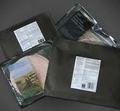



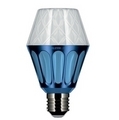
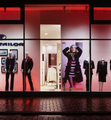


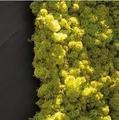
Comments by our Users
Be the first to write a comment for this item.